Jefferson Vineyards Wine Blog
In the Vineyard: Verasion
In early July, we begin to see verasion in our vineyards. Verasion is a part of the grapes’ ripening process in which they change color and sweeten. Red wine varieties change from green to red, while white grape varieties, already a bright green, become more translucent. During this process, the plants stop growing new shoots and, instead, put their energy into fruit production. Once the fruit change colors, the remainder of the ripening process takes anywhere from 30-70 days until the grapes are ready to be harvested to make wine. We see the first signs of verasion in our Pinot Gris vines. Our team will begin netting the vineyard, to protect the sweetening fruit against birds, deer, and everything else.
Chilled Reds & the Grill: A Perfect Match

With a change in seasons comes a change in preferences. Long ago we traded heavy dishes for the bright, fresh flavors of Spring. For Summer – a Virginian Summer at that – again we seek food and refreshments to compliment the season. Now, we are grilling to enjoy the warm weather, bringing friends and family around for a meal made outdoors to be enjoyed on the spot. To drink, nothing but the most refreshing beverages will do. You might habitually reach for a beer, but don’t tuck away that fine red wine just yet. Below, find everything you need to know to delight in a glass of red chilled just right for a hot summer’s day - plus the grilled pairings to match.
To Chill A Wine

No longer do you need to forfeit your favorite red wine to summer’s sweltering heat. If handled correctly, even full-bodied red wines can be enjoyed year-round. Better yet, many experts recommended chilling your red wines but there is a careful balance to strike when doing so. If chilled too much, red wines become more tannic while the wine’s flavors become more subdued. If served too warm, the wine’s structure softens, subduing its acid, alcohol, and flavors. Of course, each wine calls for a slight variation in chilling protocol.
Generally, when served between 55-60 degrees, a wines’ best flavors surface. Lighter-bodied wines with a higher acidity do better with lower temperatures - the equivalent of about ninety minutes in the refrigerator. Meanwhile, full-bodied, tannic wines are best served slightly warmer– roughly forty-five minutes spent cooling down in the refrigerator. Alternatively, if you chill bottled wine in an ice bath mixed with a bit of table salt, you can bring down its temperatures more quickly. You may find you prefer certain varietals or vintages chilled to different degrees but whatever your preference may be, a perfectly chilled wine will be wonderful and refreshing. Enjoy it on its own or pair it with the right grilled cuisine to capture summer at its best.
Complimenting the Grill

What could more aptly describe summer gatherings than a grill in full blaze and the accompanying sizzle of fresh foods charring in neat streaks? For every perfectly chilled red, there is a grilled mate to match.
From the grill, foods gather flavor – smoke, salt, and spice interwoven. Charr marks themselves present a near peppery spice - this is without accounting for what seasoning may have been added beforehand. To complement the accents provided by the grill, the best wines will give brightness that balances its smokey notes without canceling these accents completely. In this way, reds – particularly chilled reds – are a fantastic option. The dark fruit flavors that define so many reds offer a ‘just right' sort of brightness while the notes of oak, tobacco, and spice that distinguish a range of reds pick up on the grill’s spice additions. When chilled, these favors and structures are heightened while the wine’s cool temperature refreshes its consumer.
A Perfect Match: Vin Rouge

Just as the type of wine will influence the temperature to which it is best chilled, the type of meat will determine the wine with which it is best paired. As a rule of thumb, the leaner the meat, the lighter the wine. The smoke and spice components added by the grill expanded the catalog of well-suited wines. Where once a poultry dish may have best matched a white or rose style wine, when charred on the grill, a light-bodied red offers fruitiness to the dish.
A similarly light-bodied wine would be a wonderful option for the vegetarian grillers among us. A grilled portobello mushroom, perhaps, would be best complemented with a light-bodied wine whose subtle tannins won’t overpower the tender earthiness of the mushroom. Look for a wine not dissimilar to our 2019 Vin Rouge, for instance. With candied red fruit aromas, a palate bursting with red cherry flavors, and a smooth finish with soft tannins, this wine would chill beautifully. Balanced sweetness, red fruit flavors, and soft tannins contribute complimentary freshness to the grill’s savory flavors with just enough structure to cleanse the palate and accent its accompaniments.
A New Summer Staple: Meritage
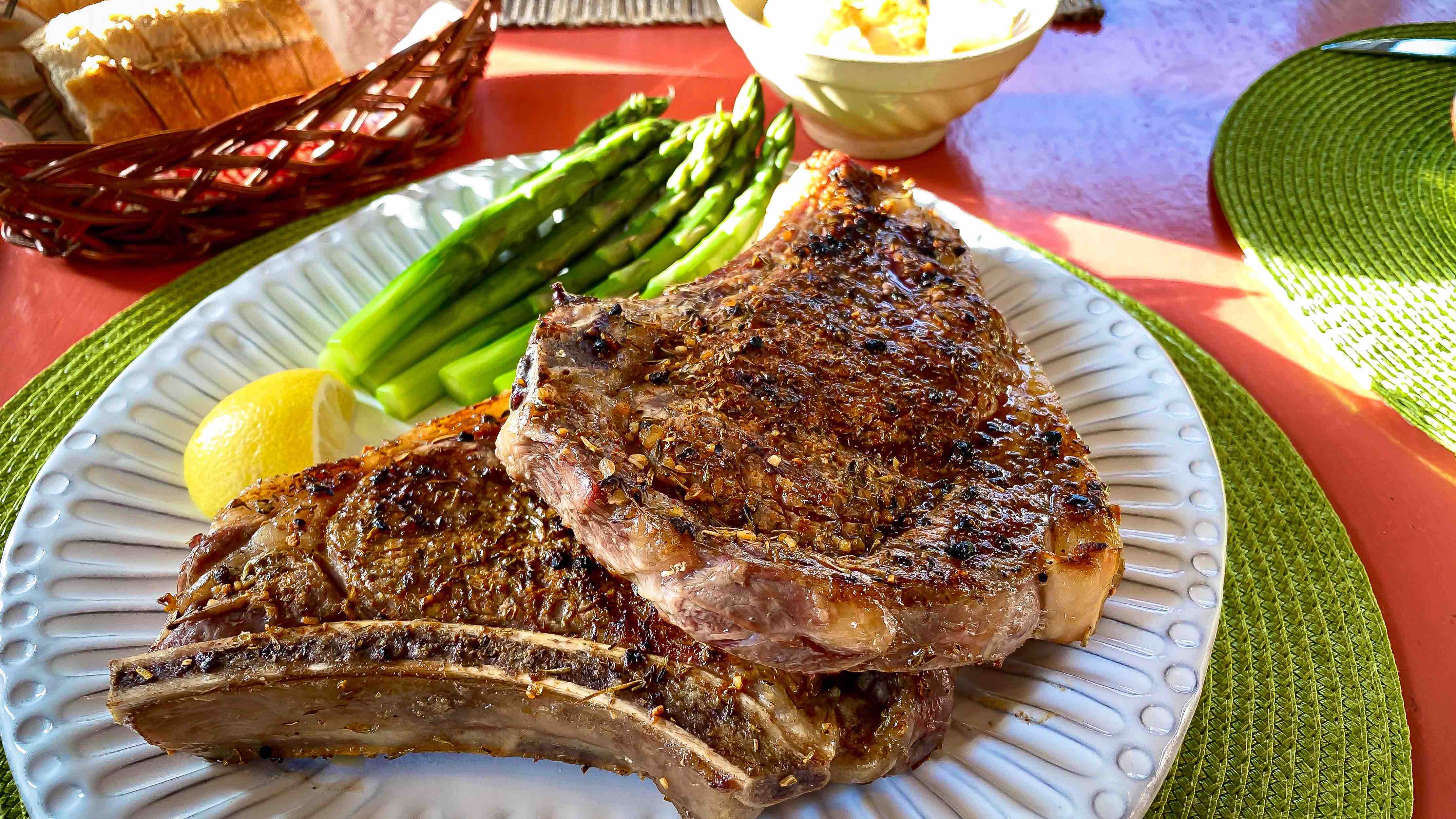
For beef and fattier meats, venture into the world of medium-bodied reds. The higher tannins of a medium-bodied wine provide structure to the wine and cuts through the fattiness of the meat and resets the palate. Better yet, medium-bodied wines with notes of spice, pepper, and tobacco amongst bright fruit flavors enhance the grills charred flavor additions. Accordingly, we recommend any number of Meritage wines.
A Bordeaux style blend, Meritage wines are well-balanced medium-bodied with intricate berry, cedar, and spice. Our 2015 Meritage for instance, opens with cedar, oak, and blackberry on the nose. On the palate, dark cherry, and berry flavors reign supreme with a bright acidity before finishing with tannins and a lingering spice. Our 2016, 2017, and 2018 vintages each distinguish themselves with slight blend and vintage variation but all are delightful to enjoy chilled and would offer structure bold enough to balance grilled steak, pork, or your favorite burger.
We've collected these, our most chill and grill-worthy reds, in this month’s Featured Wines Collection. So, put your favorite red in the fridge while you stoke the grill. Your beloved fruit-forward wine might just become a summertime staple.
Brooke Savage & Our Bees

Brooke regularly visits our ten hives to check and care for the approximately four hundred thousand honey bees on our estate. A beekeeper for Elysium Honey Company, Brooke’s primary concern is for the wellbeing of these honeybees. We rely on bees and like pollinators to support a significant portion of the world’s plant life – our food included. She knows the bees’ patterns, the subtle language between a queen and her hive, and can explain in detail all that’s happening within the ten, stacked pastel-painted boxes the bees call home. She knows when there will be honey, when there is a threat of pest, and can read the bees well enough to hold a buzzing frame with her hands, unprotected. Attuned to the bees and to each passing season, she can tell you what blooms and blossoms the bees are enjoying each month, be it Apple Blossoms, or the white clovers speckling the fields, or the Tulip Poplars spread across our land.
This month, she harvested honey – only the excess of what the bees produced – and explained the process, step by step:

“The smoke is used to calm the bees and has the added benefit of masking a pheromone that alerts the bees to an intruder, the "alarm pheromone". A guard bee will bump us, dropping pheromone which serves as a guide for the reinforcements (Hive number eight would not be easily dissuaded by the smoke however). During the harvesting process we use it judiciously and sparingly, too much smoke irritates the bees and can flavor the honey. After such a long wait, we want the honey to taste exactly as the bees make it…

"To process, we first cut off the wax that caps the honey cells to release the flow. That is also the wax that makes lip balm and candles and then it is placed in a centrifuge - an extractor. A lot of the flavor resides in pollen cells as well, so we use a micron filter to allow as much of the natural honey flavors to be retained…

“Busy as a bee is well phrased. They are amazingly productive, and when the environment provides, they will collect as much as they can, far exceeding their needs… The upper boxes above the brood chambers are called "supers", short for superstructure. That means that anything they store there is surplus. We never harvest below the supers. Please also note that I am very conservative with the harvest too - I leave a minimum of 40lbs of honey on each hive to get them through the "dearth “in July and August, when most of the nectar sources have dried up, and the bees need a good supply of stores to get them through till the next nectar flow in the fall… Each colony at Jefferson Vineyards has at least 56lbs of honey to get through to late August, when the asters and goldenrod bloom and provide a nice nectar flow that the bees fill up on for the winter…

“It is wonderful when the weather, the forage and the honey bees collaborate to create an excess harvest like we had [at Jefferson Vineyards] this spring. The late summer delight of spending the afternoon with calm, healthy bees cannot be beat. They alight on your arm and the busy sound of their wings and vibrations is supremely delightful. The best feeling is knowing that they are doing just fine.”

Jarred and delivered by the Elysium Honey Company, the honey from these hives will be our second 100% estate honey harvest since we established the apiaries in 2019 (available soon!). With Brooke’s care and oversight, our bees are happy, healthy, and thriving.
As you notice bees this summer, note Brooke’s parting reminder: “it is the absence of bees in an environment that is alarming, not their presence. When you see honey bees visiting you on the patio, please endeavor to enjoy them. They are defensive, not aggressive. Leave them be and they will go about their highly productive business.”
Our estate honey will be available for purchase this late fall.

Robert Goldie, Our English Gardener

Twenty years ago, Robert joined Jefferson Vineyards and has been creating and caring for our gardens ever since. Born in England, Robert will tell you his life has centered around travel and horticulture. He specializes in the English Cottage Garden style, a style characterized by bright blooms, full garden beds, and bustling ecological life. Cottage gardens are not manicured or meticulously planned but curated and designed with spontaneous personal preference and available bed space. They celebrate natural beauty and connection, the simple wonder that springs forth when you collect beautiful things, teeming with life, and disregard ‘ought to’ and linear ‘perfection’. In his gardens, Robert aims to surprise and delight the onlooker with an array of self-seeding plants. For eight months of the year, these gardens bloom providing habitat for pollinators, birds, and insects while organically controlling pests. Swallowtail butterflies lay eggs in the Bronze Fennel beside the patio. The bright green shoot barely reaching above the stoned wall most likely will have come from a parent plant across the parking lot. Each is allowed and encouraged to flourish. For us, the onlookers, the gardens burst forth in bright blooms – at once comfortable and strikingly beautiful.
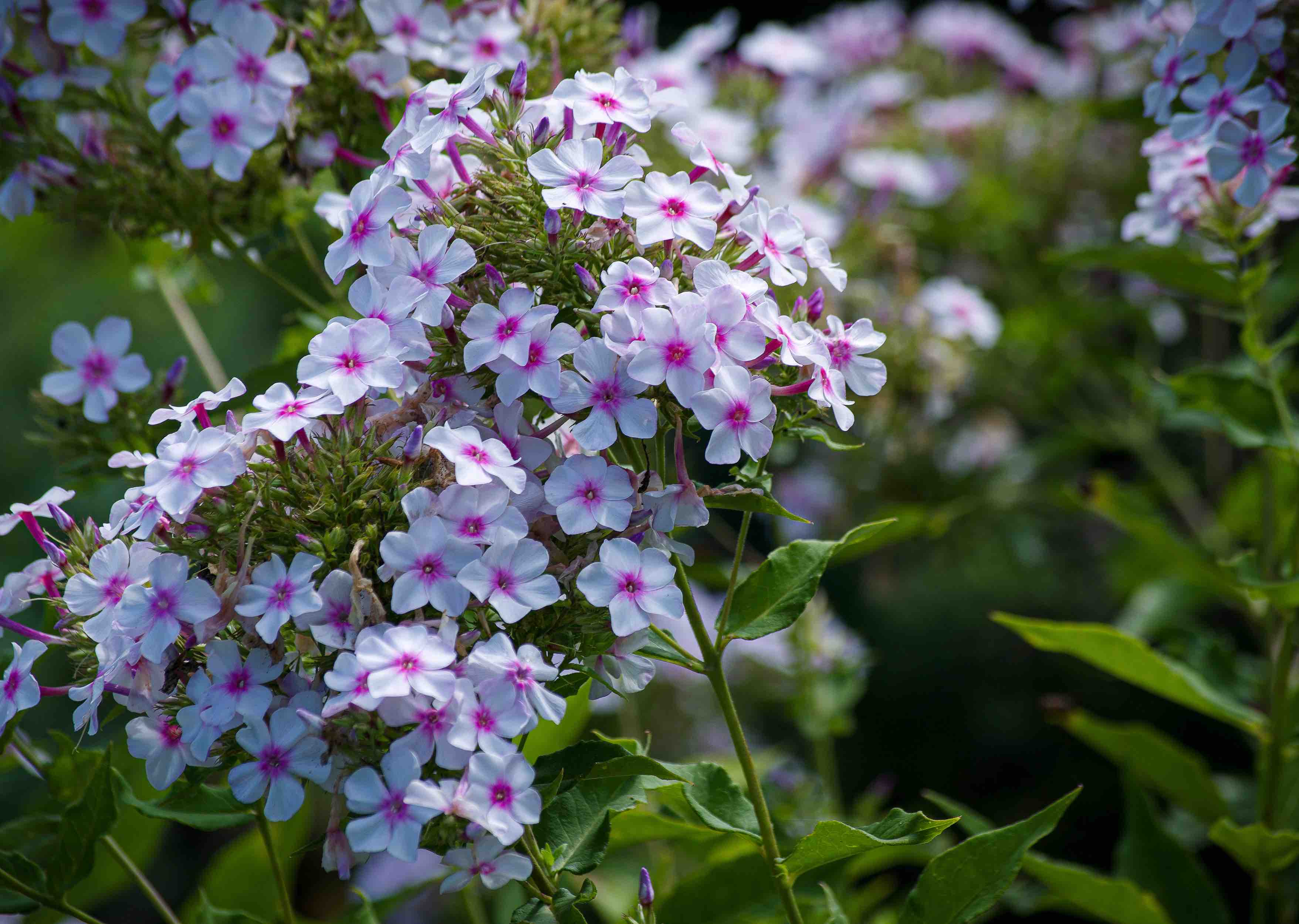



Caring for Our Community

For forty years, we have been fortunate to be a part of the Charlottesville community. We have hosted festivals, welcomed loved ones to our grounds, enjoyed music together, and spent time with one another beneath an expansive Virginian sky. We have served as stewards of this historic land, investing in the wellbeing of its inhabitants and ecosystems. Just as we have cared for the land, we are caring for this community.
In celebration of our 40th Anniversary, Jefferson Vineyards has partnered with the Blue Ridge Area Food Bank, to support its mission of alleviating hunger throughout the Blue Ridge Area. The challenges of the past year continue to shake many members of our precious community. Accordingly, we have committed to a donation capable of providing approximately 48,000 meals across the Thomas Jefferson Service Area.
Should you wish to join us in supporting this worthy cause, please find a donation link here.
Brian Morse, The Land and its Ecosystems
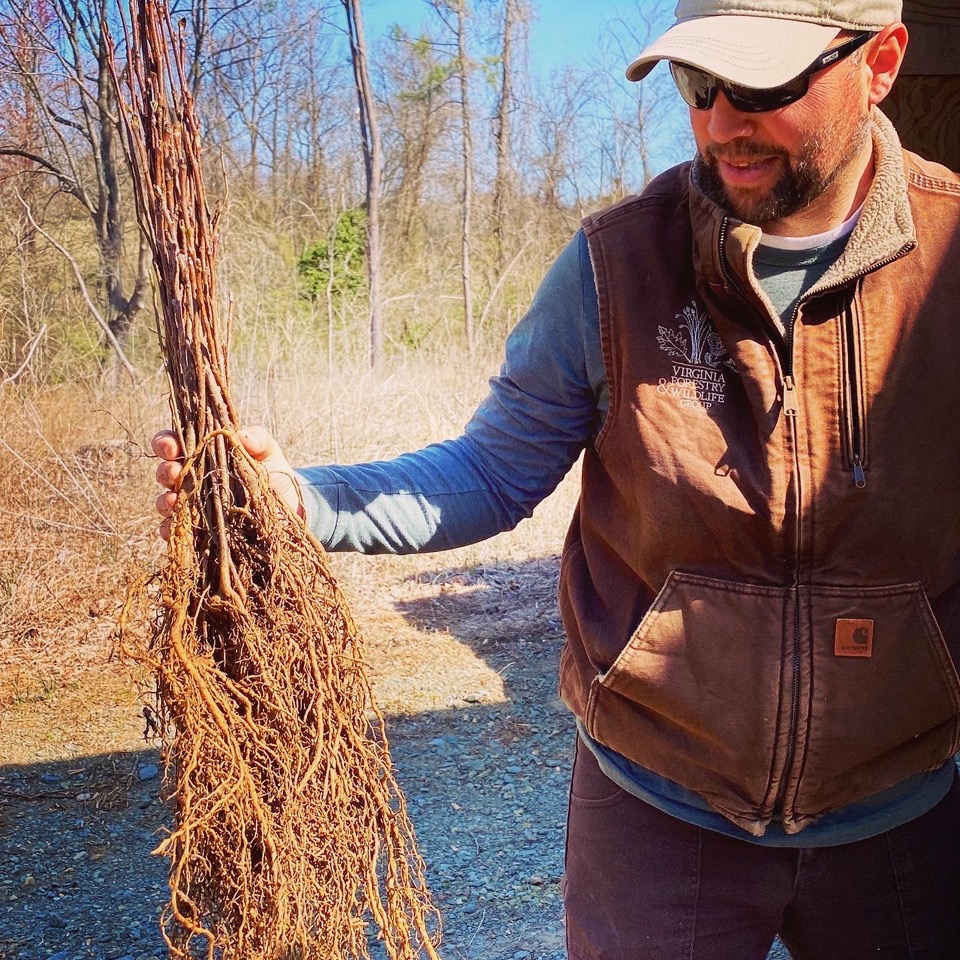
In 2017, we began working with Brian and his team to optimize our land for ecological support and environmental wellbeing. Brian is a Principal Wildlife Biologist with the Virginia Forestry and Wildlife Group. With his guidance, we have undertaken two massive initiatives: the transformation of unused land into wildflower meadows and reforestation with Tulip Poplar trees.

Four years ago, Brian and his team transformed eight acres of our land into wildflower meadows. These meadows bloom slowly and steadily for much of the year with an array of native plants, planted to provide diversified and sustainable nutrients for pollinators, including our ten apiaries and the over 400 different Virginian bee pollinator species. Now, in Spring, the largest meadow overflows with knee-high flowering grasses, interspersed with bright yellow blooms and purple-tinged foliage. We have, in turn, seen a tremendous uptick in pollinators among the meadows. In 2020, Brain and his team began a second initiative with us - the reforesting with Tulip Poplar trees. Under his guidance, we planted 12,500 Tulip Poplar bare-root seedlings on our property to replace harvested Loblolly Pines. Unlike the pines, the carbon-capturing Tulip Poplars better supports pollinator populations and adds native diversification to our local ecosystems. With Brian’s counsel and extensive knowledge, we are proud to make the most of our resources, striving to conserve and revitalize this precious land.

In the Winery - Blending & Bottling
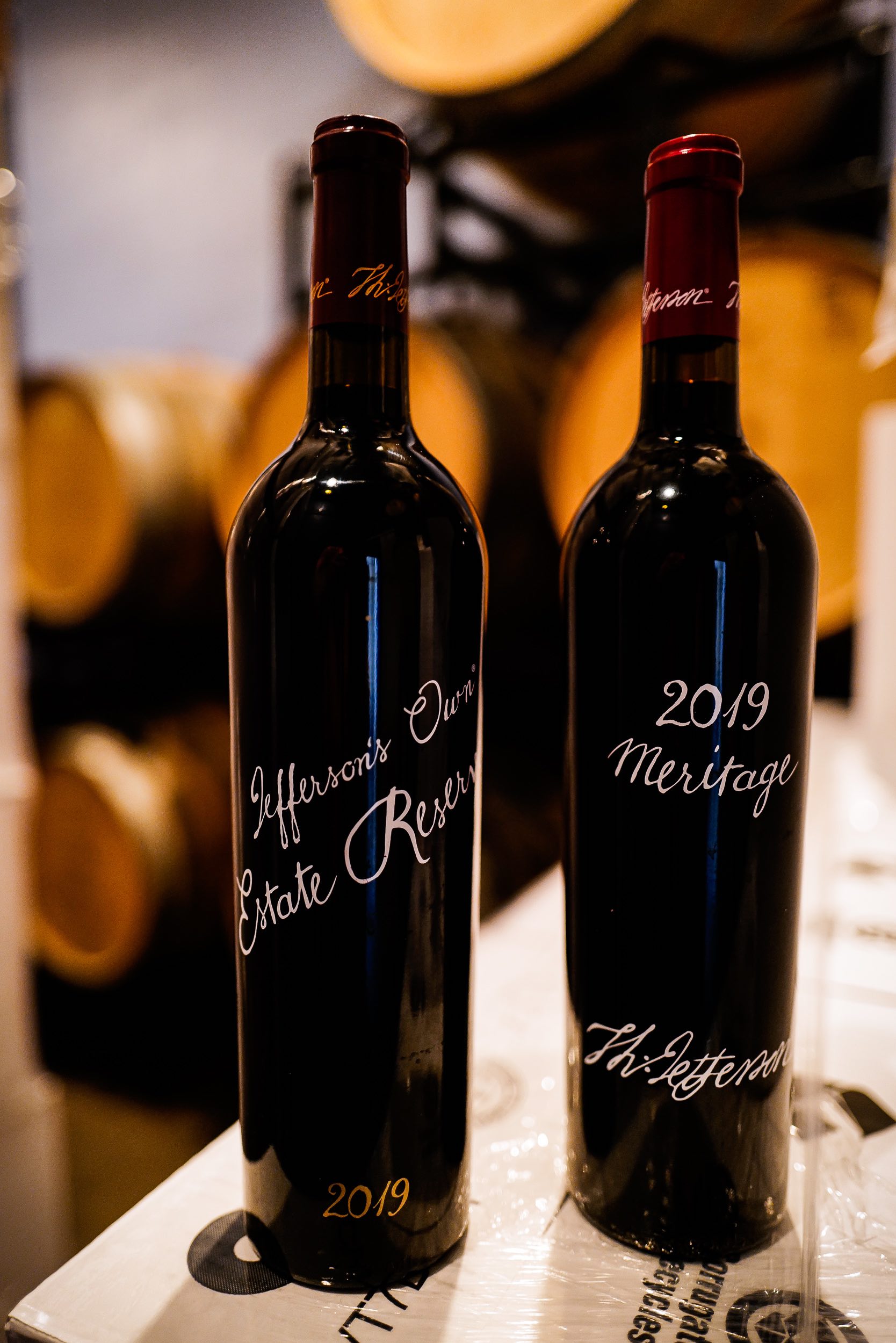
Before blending and bottling our wines, our winemaking team experiments with different blends to create the best possible wines. Considering everything from varietal to the influence of a particular barrel, we pick and choose to create wines that best display a particular vintage. Varieties are blended to create consistency and to enhance elements in the finished wine, elements that vary from vintage to vintage. Barrel-aged wines differ from barrel to barrel, each lending unique characteristics to the wine with which we determine the best blends. Trial by trial, the best iteration of the wine becomes clear. On June 16th, we bottled four more of your favorite reds from the spectacular 2019 vintage: Meritage, Merlot, Petit Verdot, and Estate Reserve. Once the reds are bottled, we’ll begin preparing our 2020 Viognier, our latest vintage. Before late July, we’ll do additional trial blends, cold and protein stabilize the wine before filtering and finally bottling this delicate, golden-hued wine.

In the Vineyard - Fruit Setting & Vineyard Management

Our Chardonnay, Pinot Gris, and Riesling vines are in the “pea berry stage”, while our red varieties, alongside Viognier and Petit Manseng, trail about a week behind. In the past weeks, flower blooms have become fruit, a process that commences only after the flowers have been pollinated and the fruit has set. While early grapes develop, our team busies themselves cleaning trunks, shoot positioning, shoot thinning, and leaf pulling. Trunk cleaning, shoot positioning and shoot thinning address how the vines grow - (in order) removing sucker shoots from the trunk, arranging desired shoots into neat vertical positions, and removing extra shoots to promote airflow and reduce crop load to ideal numbers. With leaf pulling, or canopy management, we remove additional leaves in the fruiting zone to better expose the fruit to the sun. This practice helps to control how much energy the vines are pulling into the fruit versus the leaves and encourages additional airflow to protect the fruit against mold and mildew. These tasks keep our team busy for the whole of June and July when, with early signs of verasion, we will begin netting the vineyard.

June's Blooms, Butterflies & Bees

To arrive at our property this time of year is to find yourself surrounded by green: lush pastures, rolling hills, the wooded mountain, and the green rows of Pinot Gris and Chardonnay vines set against the red roof of St. Luke’s Church. All of this is visible from the acres dedicated for guests to enjoy our wine, yet this spectacular vista is a sliver of the bigger picture. Our estate stretches across 700 acres, from the forest line atop Carter’s Mountain to Jefferson’s Monticello to Monroe’s Highland home. Since our beginning we have cared deeply for this land, investing in its health and wellbeing well beyond the benefit to our vineyards.
Preserving Our Land & Water

In the 1970's the first generation of Woodward owners, Shirley and Stanley Sr., placed nearly 700 acres under conservation easement in perpetuity, setting the stage for our county to have the third most land conservation in Virginia. With this act, the Woodward’s protected our land from future development and inspired others around them to do the same. Our vistas, the beauty of the natural world, and the historic corridor upon which we sit will remain as is for generations to come.

The first Woodward owners made clear their belief that this land and its resources are worth protecting. Each subsequent generation has followed in their footsteps and cared ceaselessly for the property. As we have preserved our land, we have worked to protect waterways from harmful agricultural runoff. The streams and tributaries that pass through our property eventually filter into the Chesapeake Bay, one of the largest estuaries in the United States. We protect these precious resources from our cattle operation by constructing extensive fencing at least 90 feet away from on-property waterways. Though the health of the Chesapeake has improved, we continue to do our part, reducing the impact of our cattle on our waterways as best we can. Most recently, our environmental attention has turned towards our pollinator populations.
Supporting Our Pollinators

Pollinator populations have been in decline for years – 50% of honey bee hives collapse annually in the United States [1]. This population decrease is a threat not just to pollinators, but to us all. Pollination is critical to the wellbeing of ecosystems and the success of agriculture. Some experts have estimated that about one-third of every bite of food we eat exists thanks to pollinators like bees, butterflies, and other insects [2]. The predominant threat to these precious pollinators is simply the loss of healthy habitat – a problem remedied by ensuring hives are located on healthy land with robust forge and ecosystems. Accordingly, we have tried to provide a home and habitat for these critical creatures.

We host ten apiaries on our property to foster honey bee populations. Honey bees are a super-organism, a collective of individuals and generations working selflessly together for the survival of the whole colony. Each of these apiaries safely houses a queen bee and hundreds of thousands of bees, giving them space in which to build their hives and bolster their populations. Beyond a safe haven, we have transformed acres of our property to provide ideal food and habitat. Seven of our acres are now dedicated wildflower meadows. Spread between three distinct plots on our 700 acre property, these meadows are filled with native wildflowers.

Additionally, in March of 2020, we planted 12,500 Tulip Poplar Trees to bolster critical ecosystem diversity. Unfortunately, many native trees in our area have been replaced by Loblolly Pines as a source of timber. By planting Tulip Poplar trees, we repopulate our land with one of Virginia’s largest native tree species. Adult Poplar trees bloom in vibrant color; their large flowers are a near-neon yellow with a halo of orange around its base. Jefferson himself described the Tulip Poplar as “The Juno of our Groves" and planted one at Monticello [3].
 Upon returning their hives after visiting these floral oases, our bees transform the collected pollen into honey. The honey serves as food for the bees to help them survive the winter. We harvest any extra honey as a partner farm of the Elysium Honey Company. Elysium Honey is a local organization dedicated to caring properly for local pollinator populations and sharing the amazing, unaltered honey that comes from these hives. We provide the utmost care for our bees and are thrilled to soon share our first ever, 100% estate honey.
Upon returning their hives after visiting these floral oases, our bees transform the collected pollen into honey. The honey serves as food for the bees to help them survive the winter. We harvest any extra honey as a partner farm of the Elysium Honey Company. Elysium Honey is a local organization dedicated to caring properly for local pollinator populations and sharing the amazing, unaltered honey that comes from these hives. We provide the utmost care for our bees and are thrilled to soon share our first ever, 100% estate honey.
The Gardens You See

Arriving on our property, you will find yourself surrounded by a sea of lush green in the midst of which bursts our brightly colored English Gardens. Bordering our patio, this Cottage Garden was designed to bloom eight months of the year, attracting butterflies, bees, and more beneficial insects into this ecosystem. These gardens remind us of all that is precious and beautiful about our land, and Virginia. So, as you enjoy your wine in view of the garden’s spectacular color think of the Tulip Poplars and wildflower meadows tucked out of sight, know the water that filters through our grounds is being cared for, as are the honeybees that float amongst the flowers.
To further welcome the end of Spring, we’ve selected wines that best reflect this spectacular season, each fruit-forward and full of floral notes. The Traminette 2019 is our most floral wine, with rose, easter lily and pear on the nose – a bouquet reminiscent of exotic perfume. Our Riesling too greets you with notes of lavender while each of our rosé wines boast berry notes and are themselves a burst of color as bright as Spring. Find each in our Limited Release Shop.

[1] “The Elysium Honey Co.” The Elysium Honey Company, www.elysiumhoney.com/.
[2] “Natural Resources Conservation Service - Insects and Pollinators.” NRCS, USDA , www.nrcs.usda.gov/wps/portal/nrcs/main/national/plantsanimals/pollinate/.
[3] “Tulip Poplar - Liriodendron Tulipifera.” Monticello, The Thomas Jefferson Foundation, www.monticello.org/house-gardens/in-bloom-at-monticello/tulip-poplar/.
In the Vineyard: Flowering
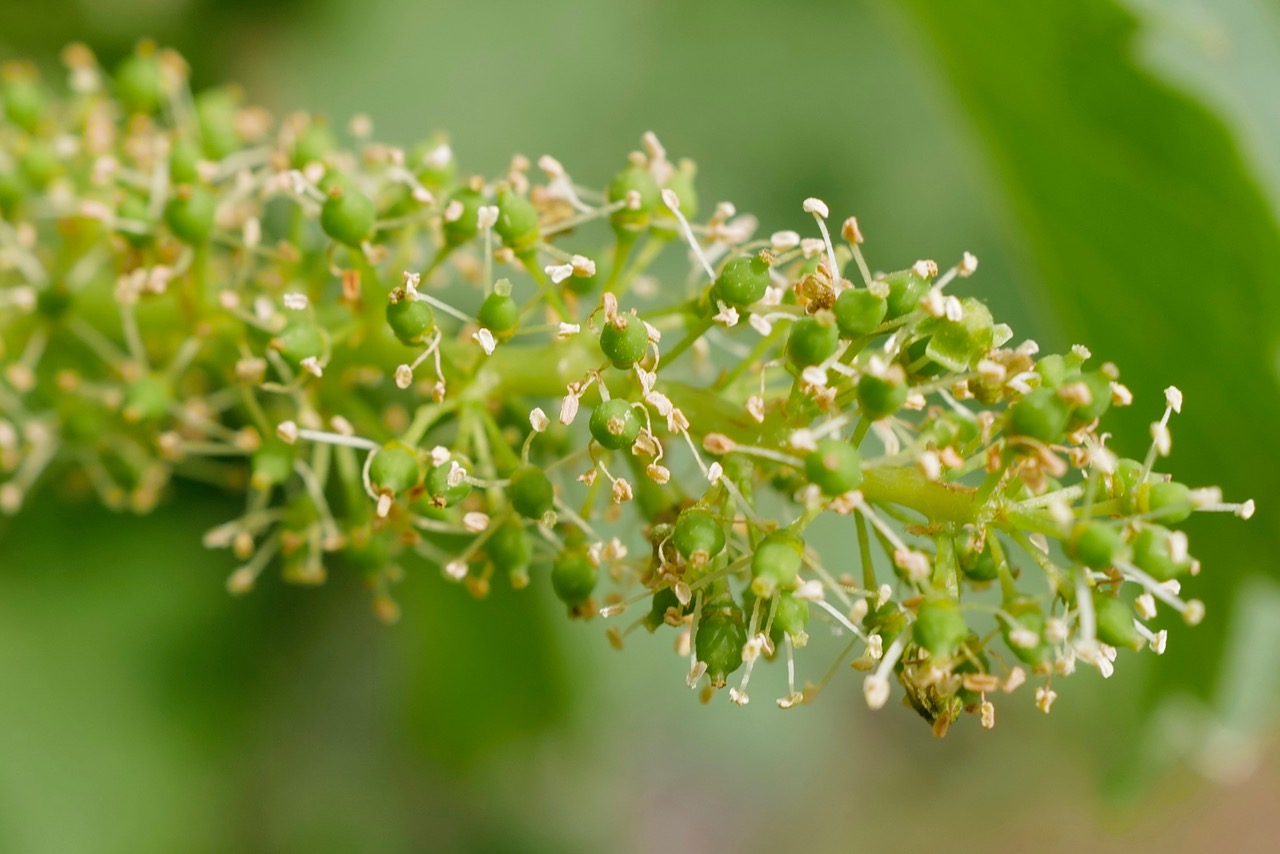
Spring has arrived in full. Now that the threat of frost has passed, a season of spectacular growth has begun. In Mid-April, dormant vines first burst into life during bud break. Now the grapevines enter the critical flowering phase. Miniature green spheres which house the pollen-carrying parts of the flower called “calyptras”, or “caps” develop underneath a wild canopy of new leaves. At the vine’s discretion, these caps open to reveal a minimalist flower - just a pistil and pollen-carrying stamen. Slowly but surely, the pistil is pollinated and each flower transforms into a tiny green berry which itself becomes fruit - the makings of a wonderful harvest.


